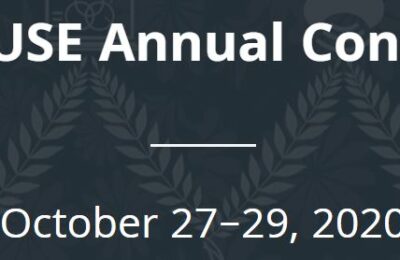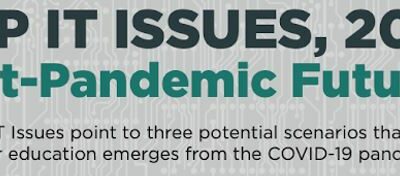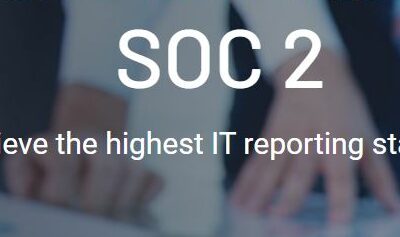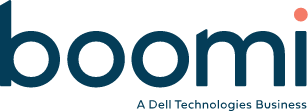EnlightenEd
EDUCause IT Issues 2021: The ‘Restore’ Scenario

EDUCause’s report on the most pressing IT issues for higher ed next year, Top IT Issues, 2021: Emerging from the Pandemic, presents readers with the three scenarios facing most higher ed institutions right now: Restore, Evolve, and Transform. Today, as part of our ongoing series on the report, we’re focusing on the first scenario, Restore.
Higher ed institutions that are facing what the EDUCause report describes as the ‘Restore’ scenario aren’t currently looking to use the pandemic to make massive structural changes to the way they operate. Instead, they need to focus on restoring the financial health of the institution to its pre-pandemic state. By doing so, they’ll be able to continue offering their students the quality education they’ve come to expect, while also adjusting to some of the pandemic’s effects on how that education experience is delivered.
According to the report, the top five IT issues prioritized by institutions finding themselves in the Restore scenario are:
-Cost Management
-Online Learning
-Financial Health
-Affordability and Digital Equity
-Information Security

As you can see, the pressing issues for these institutions are split fairly evenly between finances and the move toward an online educational experience. Tackling both of these problems together may seem impossible, as expanding digital equity and access generally requires new tech—and new tech is expensive.
Fortunately, N2N’s turnkey cloud integration platform, Illuminate, is up to the task.
When it comes to the issues of cost management and financial health, Illuminate has a clear and obvious benefit to institutions looking to get the most of their technology stack while staying within tight budgets. Illuminate can integrate all the different tools, platforms, and databases on campus—without the need for hiring custom coders or using in-house IT resources. The integration is fast, easy, and affordable, and tools can quickly be added or removed as needed.
Illuminate allows institutions to leverage their existing resources in an affordable way, and to be efficient in managing their infrastructure, as well. While it can sometimes seem like building custom integrations in-house is the smartest route to take, it all comes down to the question of free beer vs. free puppies, where custom integrations are the equivalent of free puppies, in that they seem free upfront, but end up costing a significant amount in care and upkeep on an ongoing basis.
On the educational side, Illuminate also places institutions in an advantageous position, allowing them to easily add the apps and data sources they need to create greater digital equity across the student population. Whether the goal is recruiting students, helping them enroll, expanding access to online resources, or supporting student success, adding the right app or platform to your existing SIS setup has never been easier – and Illuminate’s new Student Success Module, Lighthouse, was developed specifically to give your institution the data necessary to identify and guide at-risk students, to help them stay on track and graduate on-time.
So, if your institution is facing the Restore scenario and you’re concerned about how you can manage costs while expanding digital equity and online learning, contact us at 1(888) 651-3309 today! We’ll be happy to talk you through the benefits of Illuminate for your campus.
More EnlightenEd Entries
EnlightenEd
EDUCause Issues Its Annual Report on Top IT Issues In Higher Ed – With a 2021 Twist

2020 was a year of radical changes, realignments, and fights for survival in many industries. As we all know, higher education was no exception.
EDUCause’s newest report, Top IT Issues, 2021: Emerging from the Pandemic, reflects the monumental challenges institutions have faced this year. Instead of their usual list of the top 10 IT challenges facing higher ed, EDUCause took a novel approach, basing their report on three scenarios that higher ed IT leaders have indicated their institutions may be facing as a result of the pandemic.
Within each scenario—Recover, Evolve, and Transform—are five issues that IT leaders noted as being most important to them.
This infographic they created gives a solid overview of the issues discussed in the report:

Restore – For institutions facing this scenario, the primary focus is on restoring their finances and surviving the turbulence the pandemic has caused. They also see the vital importance of ensuring digital equity for their students and creating a strong online learning experience, but that has to happen in tandem with a restoration of the institution’s financial health.
Evolve – Institutions that fall into the Evolve scenario are still concerned about finances, but are focused more heavily on student experience issues. Online education and equitable access to that education feature prominently in their concerns, as well as student success related to attaining academic and career goals.
Transform – The institutions in this category are using the pandemic to make large-scale structural changes, launching or accelerating a new agenda that will transform the way the institution fulfills its mission. These institutions are proactively looking to align a heavy focus on technology with their goals of recruitment, enrollment, and education.
Out of the three, you’ll notice there is a good amount of overlap between Restore and Evolve. The institutions in these scenarios face many of the same issues, but due to their individual circumstances, are choosing to place a heavier focus in different places. Institutions in the Transform scenario are taking a more radical approach and therefore face their own set of unique issues.
Regardless of where your institution falls—Restore, Evolve, Transform, or somewhere in between—N2N’s Illuminate platform can help you face those issues head on and provide the best possible experience and education for your students. Right now, change continues to come quickly and unexpectedly, so you need the ability to leverage your institution’s data more than ever. Illuminate is the perfect platform for these unprecedented times, providing a systematic way to integrate your SIS with any other tools you need, so that you can actually use your data to grow more efficient and effective. However you decide to tackle the issues EDUCause has highlighted, Illuminate will be there to help you quickly, affordably, and painlessly integrate new technology on your campus.
We’ll be diving deeper into the EDUCause report in future posts, so stay tuned to learn more about each of these scenarios and how your institution can position itself to thrive amidst uncertainty.
Want to learn more? Contact us to find out how we can help you solve your campus IT and data integration issues today!
More EnlightenEd Entries
EnlightenEd
EDUCause Virtual Conference 2020: A Recap

N2N Services recently attended the 2020 EDUCause Annual Conference, showcasing the best thinking in higher ed IT.
However, this year’s EDUCause was very different from past years due to the ongoing coronavirus pandemic. Instead of physical booths at an in-person conference, N2N and other presenters operated “virtual booths” and the entire conference was held remotely.
Two of those in attendance for N2N were CTO Joel Dunn and VP of Business Development Danielle Whitney. Both gave some insight into what went well this year, as well as the areas where they felt the virtual event fell short of a live, in-person conference.
The implementation of technology was an area where both agreed EDUCause did an excellent job. “We thought that the virtual booth and the framework around that was very well done and EDUCause provided nice tools to support the interaction,” reported Joel.
Danielle concurred—with one caveat. “The virtual booths and the tech that supported them worked well, but you just can’t replicate candid conversation with any kind of technology.”
That points to the largest issue that anyone manning a virtual booth faces: the difficulty in creating easy, spontaneous conversation through video and chat. The amount of interaction that happens when attendees are physically present and moving from booth to booth just wasn’t there this year.
And part of that, according to Joel, is simply due to the social dynamics of attending an event instead of calling in from home. At an in-person conference, 5:00 p.m. generally signals more conversation—often with a drink in hand. But when attendees are virtual, five o’clock means dinner time with the family.
There were bright spots, however. “At one point, I was talking with someone in the live chat and we switched over to a phone call to make things a little easier and build a better connection,” Joel recalled.
For Danielle, one of the disadvantages to the virtual setup was that most people considered this a one-off event—and that everything would go back to normal next year. So, adoption of the necessary tech by attendees was a little slower than everyone had hoped. She noted, “The people at this conference are at the executive level, they don’t really have time to invest in going through all these online booths. So there isn’t the same level of organic conversation.”
Still, the conference overall was a success and given the constraints, and there were a lot of innovative ideas and technology to keep everyone engaged. Danielle thought one thing the organizers did well was create the “Passport to Prizes” initiative to keep attendees moving from booth to booth. “Conference attendees had to go to booths and watch videos, download information, etc. in order to win swag that would then be mailed to them.”
While this year was different for everyone, it was a good learning opportunity and the team at EDUCause did a great job making sure the best and most innovative voices in higher ed IT could still be heard.
And in case you were wondering, we have reserved a booth for the 2021 EDUCause conference in Philadelphia—in person! Come visit us next year or, if you missed us at this year’s EDUCause, call us today for a free demo.
More EnlightenEd Entries
EnlightenEd
Laying the Foundation For a Student-Centric Campus

This is the third and final installment in a series of posts discussing critical aspects of the Educause report “Top 10 IT Issues 2020: The Drive to Digital Transformation Begins.”
In our last two blog posts, we discussed the data integration challenges institutions are facing in the context of the constantly connected student, as well as the intersection of digital transformation and faculty adoption.
Though the pandemic has urgently accelerated both the need for and the implementation of new approaches to just about every aspect of the higher ed experience, the limitations and obstacles to those new approaches that existed before covid still remain:
– IT teams still need to pour considerable time and money into the integration of new tools into an institution’s IT ecosystem.
– Faculty and staff still face a learning curve with any new tool, which sometimes results in limited adoption.
Meanwhile, students used to a ubiquitous connection and seamless digital experiences are demanding that their colleges and universities provide a truly student-centric environment for them – a campus experience that encompasses not only their physical, in-person interactions with their institution, but also their virtual interactions, whether with learning resources or administrative resources – and allows them to move effortlessly and seamlessly among them all.
Trying to find solutions that address each of these challenges is a formidable task for higher ed administrators already dealing with all of 2020’s slings and arrows.
Fortunately, there is one solution that provides a firm foundation for the creation of a student-centric campus that checks all the above boxes, one that creates a secure, easy-to-use framework for data integration that is simple to adapt to changing requirements – the N2N Illuminate platform.
N2N Illuminate is an integration platform developed specifically for higher ed, with pre-built integrations for the tools you’ve been using for years, and quick, snap-together integrations for the new tools you want to try out today.
By placing Illuminate at the center of your IT ecosystem:
– You’ll drastically reduce the IT resources needed to integrate any new tool, freeing your IT team up for other, more important tasks.
– You’ll gain much needed flexibility in the choice of tools you use, allowing you to quickly and affordably integrate and try out different ones as needed to ensure faculty and staff adoption.
– And you’ll be able to easily create a student-centered, seamless experience that will help you retain current students and attract new students.
…all while gaining the ability to quickly and easily adjust to whatever 2021 and beyond has in store for us.
At N2N, we are committed to a student-centric and seamless experience, that begins at recruitment and follows through application, acceptance, financing, learning, student success, graduation, and beyond.
Let us help you lay the foundation for a bright future for your institution and your students, no matter what lies ahead. Contact us for a free demo today.
More EnlightenEd Entries
EnlightenEd
The Intersection of Digital Transformation and Faculty Adoption

This is the second in a series of posts discussing critical aspects of the Educause report “Top 10 IT Issues 2020: The Drive to Digital Transformation Begins.”
In our last blog post, we discussed the data integration challenges that colleges and universities face in 2020 – most notably, the need for adaptability within a student-centered ecosystem. Today, we turn our focus to another aspect of the integration puzzle – the fact that faculty adoption of new tools is just as much a factor in an institution’s ability to adapt and thrive as the tools themselves.
This issue has been thrust into a glaring spotlight in recent months, with frustratingly inconsistent adoption of tools for virtual learning, varying from professor to professor. While some are comfortable using the new platforms and tools their institution has provided or recommended, others struggle to get them to work correctly or to utilize all the features – and some opt out of using them altogether.
Unfortunately, this creates an environment that is the exact opposite of student-centric – and certainly not the seamless digital experience set forth as the gold standard in the above-mentioned Educause report.
It’s one thing when inconsistent faculty adoption of an app or tool affects only a small part of a student’s college experience – it’s quite another when it impacts their daily class experience, and causes ongoing frustration all semester long.
Of course no one is blaming faculty for this inconsistent use of the tools available – the entire world of higher ed has been thrown into uncharted territory these past several months, and everyone is scrambling to figure out the best ways forward.
But precisely therein lies the solution – what if there was a simple and affordable way to rapidly experiment with different tools to find those best ways forward, quickly integrating those new tools with your institution’s other apps and databases for trial usage by faculty, and then just as quickly removing them to try another one, if the first just isn’t gaining traction with professors?
What if you were able to retain this flexibility into the future, so that you could always test new tools for faculty adoption before settling on the perfect fit – and what if doing so didn’t require using up all your institution’s IT resources for weeks at a time?
That’s exactly what the N2N Illuminate platform can do for you.
Illuminate removes barriers to institutional adaptability by making it easy to try out any new app or tool, securely integrating it into your existing IT ecosystem.
When it’s that quick and easy to test out a new tool, it becomes just as easy to find exactly the right fit for your institution’s faculty – the tool that they are all willing and able to utilize and that they can use to provide a consistent, seamless learning experience for your students on a daily basis.
No more frustration for faculty…no more frustration for students…and no more frustration for administration.
If you’d like to learn more about how N2N Illuminate can help your institution navigate our current challenges and prepare for those to come, contact us today for a free demo.
More EnlightenEd Entries













